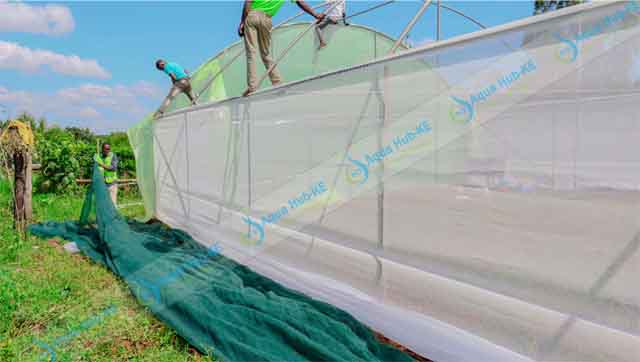Do you Know you can protect your crops from harmful pests and insects without having to use pesticides? Agricultural Insect nets are the crop protection barriers that keep even tiny insects away from your vegetable and plant fields.
Insect nets are essential especially in hot regions where pest activity is likely to be high. They have proper ventilated mesh structures which also enhance air and sunlight penetration.
Reliable insect nets are available at Aqua Hub LTD in Nairobi at KES 120 per square meter.
Cost of Insect Nets
Insect Nets in Kenya are KES 120 per square meter.
What Are Agricultural Insect Nets?
Agricultural insect nets are used to protect vegetables, fruits, and flowers from pests. They are commonly used in greenhouses or net houses, especially in high-value farming regions like Kiambu, Naivasha, and Meru.
Where to Buy Agricultural Insect Nets in Kenya
Affordable Agricultural Insect Nets are available at Aqua Hub LTD. We are the popular and trusted supplier of UV treated insect nets. Our products to all parts of the Country and delivered at affordable rates.
Call 0790719020
Key Benefits of Insect Nets
- Pest control without heavy pesticide use
- Improved quality and appearance of crops
- Better yields and reduced post-harvest losses
- Climate resilience, protecting from wind, hail, and excess sun
Common Crops Grown with Insect Nets
- Tomatoes
- Capsicum
- Spinach
- Lettuce
- Strawberries
What Are Agricultural Insect Nets?
Agricultural insect nets are mesh fabrics designed to physically block insects from reaching crops. The mesh size is small enough to keep out pests but still allows air, sunlight, and water to pass through. These nets are typically made from UV-treated polyethylene or polypropylene, making them durable and weather-resistant.
Types of Agricultural Nets in Kenya
There are several types of agricultural insect nets based on their purpose:
- Anti-insect nets: Used to protect crops from flying pests like aphids, fruit flies, whiteflies, and moths.
- Shade nets: Reduce sunlight intensity and protect plants from heat stress.
- Pollination control nets: Manage which insects can reach the plants during flowering.
- Bird or hail protection nets: Shield crops from birds and harsh weather.
Uses of Insect Nets
The most common applications in Kenya include net houses, greenhouses, and row covers for open-field crops.

Importance of Insect Net Use
1. Reduced Pesticide Use
Chemical pesticides have long been the go-to solution for pest control. However, they come with downsides: high costs, health hazards, pest resistance, and environmental pollution. Insect nets offer a safer, non-chemical alternative. By physically excluding insects, farmers can cut pesticide use by up to 70%.
2. Better Crop Yields and Quality
Without insect damage, crops grow more vigorously and produce better-looking fruits and vegetables. This translates to:
- Higher yields
- Premium pricing in markets
- Greater access to export markets with strict pesticide residue limits
3. All-Season Protection
Nets provide year-round protection against pests, making it easier to plant during off-seasons when pest pressure is typically high. This leads to more consistent income and food security.
4. Climate Resilience
In addition to keeping out insects, nets also reduce the impact of:
- Strong winds
- Heavy rain
- Intense sun
- Cold nights
How to Choose the Right Insect Net
When selecting insect nets, consider the following factors:
- Mesh size: 40 mesh (0.4 mm openings) blocks most small pests like whiteflies; 20 mesh (1 mm) is better for larger insects.
- UV resistance: Ensures the net lasts 3–5 years under the Kenyan sun.
- Color: White or transparent nets allow maximum light transmission; green or black nets offer more shade.
- Strength: For areas with strong winds or animal interference, opt for reinforced edges or high-tensile nets.
It’s also wise to combine insect nets with drip irrigation, organic composting, and crop rotation for best results.
Challenges Affecting Insect Net Use
- Lack of technical knowledge on installation and maintenance
- Limited access in remote areas
- Poor quality imports that degrade quickly.

